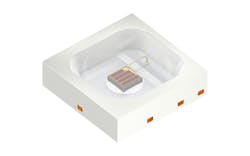Osram announces white and color Synios LEDs that span low- to mid-power applications
Osram Opto Semiconductors has announced the new Synios S 2222 portfolio of phosphor-converted, white, monochromatic color, and phosphor-converted color LEDs targeted primarily at dynamic color lighting installations. The company expects to supply the LEDs to luminaire developments spanning solid-state lighting (SSL) transportation products to outdoor lighting of architectural façades and most any application for full color in between.
As the packaged LED model number implies, the LED components feature a 2.2×2.2-mm footprint. Members of the family can be driven over the range of 10 mA to 200 mA. The low end of that range would be considered a low-power LED whereas the high end would fall into the mid-power space and not that long ago the lower range of the high-power application segment.
The Synios S 2222 portfolio includes:
- 3000–6000K-CCT white LEDs at 80 CRI
- Monochromatic blue at 445–460 nm
- Monochromatic green at 520–540 nm
- Monochromatic and phosphor-converted yellow at 583–595 nm
- Monochromatic red at 612–626
- Monochromatic deep red at 626–636 nm
Osram did not say why they were offering yellow in both monochromatic and phosphor-converted options. As we covered in a foundational article on color LEDs about five years back, there are a number of reasons a luminaire product developer would prefer either a monochromatic or converted LED. The phosphor-converted option often offers better efficacy. A monochromatic LED may have a tighter emission band.
Osram did specifically mention that the yellow phosphor-converted LED delivers 50 lm at 140 mA. Presumably, that is better performance than the monochromatic LED and that can be translated by the product developer to brighter output at equivalent efficacy or to better efficacy at equivalent brightness by lowering drive current.
The wide application target mentioned up front really spans subtle to splashy uses of color. Osram mentioned use in transportation that might include auto, plane, and train cabins. In such cabins, a multi-channel color system would be used to present comfortable ambient lighting, even with a lighting for health and wellbeing twist, say, on planes that traverse time zones. For autos in particular, Osram has been active in the ISELED Alliance that is focused on dynamic cabin lighting.
For more dynamic applications such as projecting color on architectural surfaces indoors and out, the new LEDs can deliver the needed output. Osram believes that the diminutive components are an easy match for such applications. “The Synios S 2222 product family features a unique package design that is easy to handle, allowing our customers to use automated pick-and-place systems for manufacturing,” said Mike Martens, senior product manager at Osram Opto Semiconductors in North America. “In addition, the high-quality LEDs give our customers ultimate flexibility by providing a wide range of colors to create distinctive lighting solutions.”
The LEDs can also be packed close together in arrays and stand only 0.6 mm high. The close packing and height lend the components to compact flat luminaire designs that deliver uniform and well-mixed colors. We covered the concept of such uniformity in another color LED news story a few years back. Uniform height enables matched focal lengths from the different color LEDs.
For up-to-the-minute LED and SSL updates, why not follow us on Twitter? You’ll find curated content and commentary, as well as information on industry events, webcasts, and surveys on our LinkedIn Company Page and our Facebook page.

Maury Wright | Editor in Chief
Maury Wright is an electronics engineer turned technology journalist, who has focused specifically on the LED & Lighting industry for the past decade. Wright first wrote for LEDs Magazine as a contractor in 2010, and took over as Editor-in-Chief in 2012. He has broad experience in technology areas ranging from microprocessors to digital media to wireless networks that he gained over 30 years in the trade press. Wright has experience running global editorial operations, such as during his tenure as worldwide editorial director of EDN Magazine, and has been instrumental in launching publication websites going back to the earliest days of the Internet. Wright has won numerous industry awards, including multiple ASBPE national awards for B2B journalism excellence, and has received finalist recognition for LEDs Magazine in the FOLIO Eddie Awards. He received a BS in electrical engineering from Auburn University.





